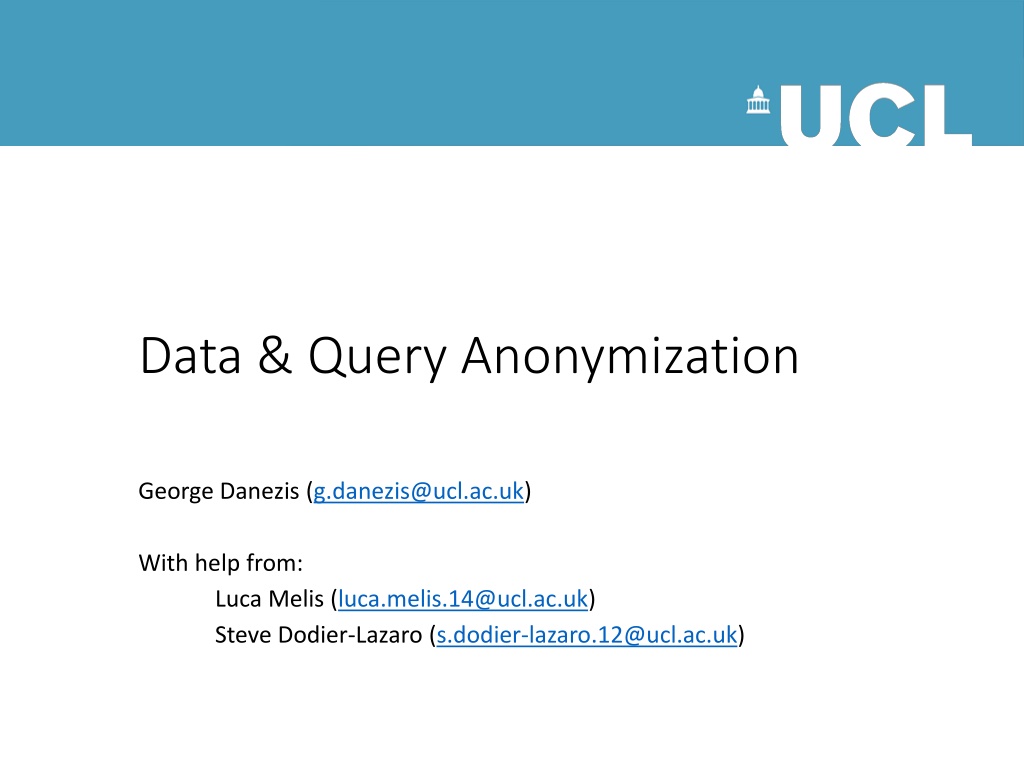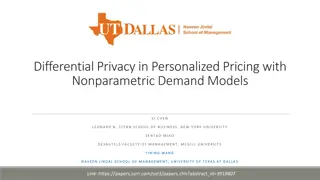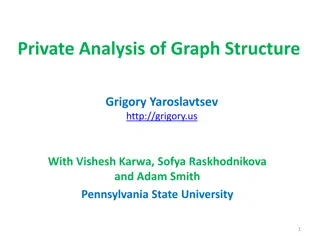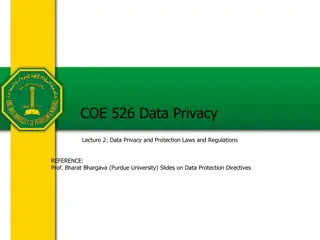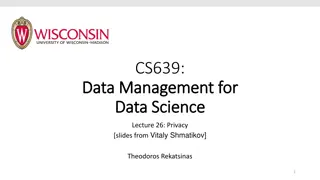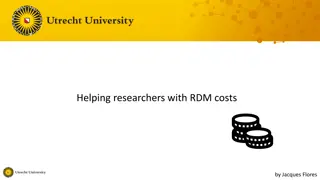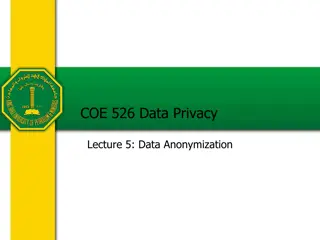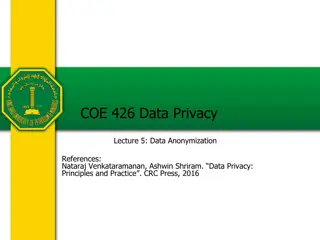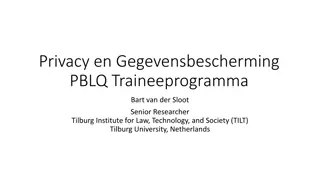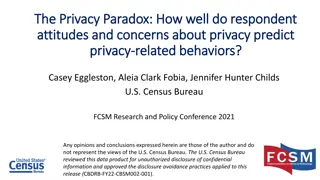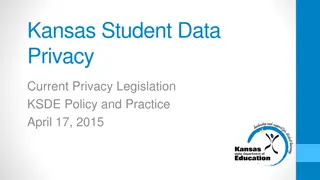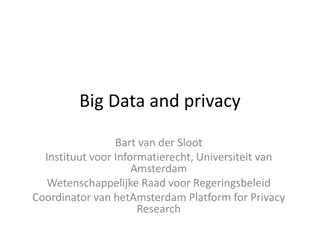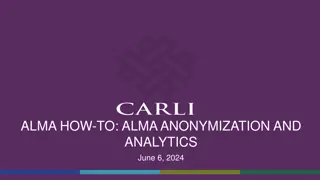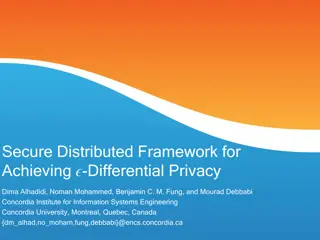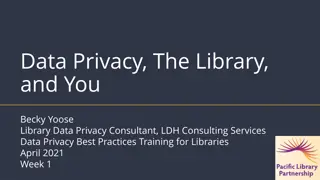Anonymization Techniques in Data Privacy
Anonymizing data is crucial to safeguard privacy, prevent data breaches, and enable sharing for various use cases, such as statistics, data science, and data release. Techniques like K-anonymity aim to protect individual identities by grouping data into subsets with shared characteristics. However, challenges like efficiency and security exist, prompting the need for advanced privacy methods like L-diversity.
Download Presentation

Please find below an Image/Link to download the presentation.
The content on the website is provided AS IS for your information and personal use only. It may not be sold, licensed, or shared on other websites without obtaining consent from the author.If you encounter any issues during the download, it is possible that the publisher has removed the file from their server.
You are allowed to download the files provided on this website for personal or commercial use, subject to the condition that they are used lawfully. All files are the property of their respective owners.
The content on the website is provided AS IS for your information and personal use only. It may not be sold, licensed, or shared on other websites without obtaining consent from the author.
E N D
Presentation Transcript
Data & Query Anonymization George Danezis (g.danezis@ucl.ac.uk) With help from: Luca Melis (luca.melis.14@ucl.ac.uk) Steve Dodier-Lazaro (s.dodier-lazaro.12@ucl.ac.uk)
Why anonymize data? Raw data use cases: Want to share within your organization, but fear they might lose the data. Want to share data outside your organization. Want to avoid the Data Protection overheads (DP principles do not apply to anonymized data). Want to protect your customers in case you are compelled / hacked. Statistics use cases: Data points: Want to provide some statistics based on the data but do not want to violate the privacy of any individual (medical research). Tables: Want to regularly publish tables of statistics (National Statistics, Gov.) Data Science: Want to provide an interactive query service on private data.
Data release disasters AOL search data leak (2006) On August 4, 2006, AOL Research, released a compressed text file on one of its websites containing twenty million search keywords for over 650,000 users over a 3-month period, intended for research purposes. AOL pulled the file from public access by the 7th, but not before it had been mirrored and distributed on the Internet. http://en.wikipedia.org/wiki/AOL_search_data_leak Anonymization technique: turn userIDs into fresh pseudonyms. New York Times managed to identify individuals from search terms. Netflix Prize (2007) Netflix released an pseudonymized dataset of movie preferences, as part of a competition into recommender systems. Researchers use information from the Internet Movie Data Base (IMDB) to de-anonymize a number of records. After 2009 the completion is suspended following a lawsuit on privacy grounds. Lesson: Pseudonymizing data is not a robust anonymization method. Arvind Narayanan, Vitaly Shmatikov: Robust De-anonymization of Large Sparse Datasets. IEEE Symposium on Security and Privacy 2008: 111-125
Can you ever release records safely? Protecting a database table with K-anonymity : Assume one person per row. Delete all personal identifiers. Identify all quasi-identifiers. Ensure at least K entries share the same set of quasi-identifiers. How? Suppression and Generalization. Eg. Using suppression and K = 2 First Last Age Race First Last Age Race Harry Stone 34 Afr-Am - Stone 34 Afr-Am John Reyser 36 Cauc John - - - Beatrice Stone 34 Aftr-Am - Stone 34 Aftr-Am John Delgado 22 Hisp John - - - Pierangela Samarati, Latanya Sweeney: Generalizing Data to Provide Anonymity when Disclosing Information (Abstract). PODS 1998: 188
Problems with K-anonymity Efficiency problem with K-anonymity: Suppressing everything is K-anonymous, but provides no utility. Expensive to find a K-anonymity transform that preserves maximal utility Security problem with K-anonymity: (K=4) K-anonymity splits columns into: identifier, quasi-identifiers, other data Problem 1: if other data has little diversity, then information may be leaked. Problem 2: in the presence of side-information any information may become a quasi-identifier. Ashwin Machanavajjhala, Daniel Kifer, Johannes Gehrke, Muthuramakrishnan Venkitasubramaniam: L-diversity: Privacy beyond k-anonymity. TKDD 1(1) (2007)
The need for L-diversity Quasi-identifiers 4-anonymous q-block q-block q-block What if I know that Jeff (zip: 13068, age: 35) went to hospital? L-diversity principle: A q-block is l-diverse if contains at least l well represented values for the sensitive attribute S. A table is l-diverse if every q-block is l-diverse From: Ashwin Machanavajjhala, Daniel Kifer, Johannes Gehrke, Muthuramakrishnan Venkitasubramaniam: L-diversity: Privacy beyond k-anonymity. TKDD 1(1) (2007)
L-diversity does not prevent disclosure Zip code Age Salary Disease 476*** 2* 20K Gastric Ulcer 476*** 2* 30K Gastritis 476*** 2* 40K Stomach Cancer 4790* >40 50K Gastritis 4790* >40 100K Flu 4790* >40 70K Bronchitis 476** 3* 60K Bronchitis 476** 3* 80K Pneumonia 476** 3* 90K Stomach Cancer Side information: Bob lives in Zip code 47678 and is 27 years old. Inference: he earns 20K 40K and has a stomach related disease. L-diversity does not consider the semantic closeness of attributes.
T-closeness Plugging that information leak with t-closeness: An equivalence class is said to have t-closeness if the distance between the distribution of a sensitive attribute in this class and the distribution of the attribute in the whole table is no more than a threshold t. A table is said to have t-closeness if all equivalence classes have t- closeness. Problem with t-closeness: data is pretty much useless for further analysis. Conclusion: it is rare that releasing data sets after sanitization can preserve both privacy and utility, particularly against adversaries with side information. Solution:Only release rich anonymized datasets under licenceto designated trusted parties. Li, Ninghui, Tiancheng Li, and Suresh Venkatasubramanian. t-Closeness: Privacy Beyond k-Anonymity and l-Diversity. ICDE. Vol. 7. 2007.
A critique of Personally Identifiable Information (PII) Myth: K-anonymity and subsequent: assume that some items may be used to identify individuals. Eg. name, address, DOB. In fact: any information about an individual may be used to identify an individual within an anonymized dataset. Example: Anonymized ID Date Location Diagnosis 100 02/8/15 Hospital A Exam (Awaiting) 100 09/9/15 Hospital B Heart Condition An anonymized medical record with no PII Question: Who can de-anonymize Patient 100 and infer they have a heart condition? A. Narayanan, V. Shmatikov: Myths and fallacies of "personally identifiable information". Commun. ACM 53(6): 24-26 (2010)
The special case of social network graphs It is extremely hard to de- anonymize rich graph data. Examples: Social networks Person preference networks Abstract Full Graph Sub-sample Attacks: Assume abstract full graph. Model anon. and other side information as samples. Deploy structural or seed based attacks to link nodes. Extremely effective! Some known seeds IMDB , some movies (not anonymized) Netflix , all movies (anonymized) Arvind Narayanan, Vitaly Shmatikov: Robust De-anonymization of Large Sparse Datasets. IEEE Symposium on Security and Privacy 2008: 111-125
Can we (at least) release statistics safely? Idea: Releasing raw data is dangerous. But, what about just aggregate statistics? Surely, the fact that multiple records contribute should make it hard to infer anything about a single record. 2 Cases: Static: E.g. The Office for National Statistics issues fixed tables. Dynamic: Analysts may issue queries to do data science. Dynamic Example: Use case: What is the average salary of some London residents? Protection mechanism necessary. Example: aggregating data should hide the contributions of a single individual. Thus it might be safe to release only aggregates. Example: The 15/15 rule: At least 15 persons contribute to a sum, and no-one contributes more than 15% of the total sum.
Attack I: Trackers Attack: 1. What is the average salary of the population of London? (Passes the rule, N >> 15). 2. What is the average salary of London except George? (Passes the rule, N >> 15). Denning (1979): In databases that accept such queries it is pretty much always possible to create a tracker . Detecting trackers is (in general) computationally infeasible. Denning, Dorothy E., Peter J. Denning, and Mayer D. Schwartz. "The tracker: A threat to statistical database security." ACM Transactions on Database Systems (TODS) 4.1 (1979): 76-96.
Example II: A smart metering A smart metering privacy example: A town has 100 households, each with an energy consumption Ei. You may query the total electricity consumption of 50 households of your choice at a time. (No fewer no more) Question: How many queries do you need to deduce the energy consumption of all households?
Towards Safe definitions: Differential Privacy Desired properties of anonymization definition schemes for queries: Should be resistant to side-information. Should compose nicely if you release more information. Should provide the adversary no more information about an individual than they would learn if the individual was not in the dataset. Can there be a stronger definition?: Learn nothing about an individual! Consider the case where you lean some population statistics. You always gain information.
Differential Privacy definition Remember: ?? 1 + ? For v. small ? Dwork, Cynthia. "Differential privacy." Automata, languages and programming. Springer Berlin Heidelberg, 2006. 1-12.
Understanding Differential Privacy Key question: DP deals with the probability of a statistic result K, given a database (Pr[K|DB]). Should we not be worried about the converse namely what we can infer about the DB given the observed statistic, namely Pr[DB|K]? A bound on Pr[?|??1] Pr[?|??2]< ?? implies a bound on posteriors: Pr ? ??1 Pr ??1 Pr[?] Pr ? ??2 Pr ??2 Pr[?] Pr[?|??1] Pr[?|??2]< ?? < ??Pr ??1 Pr ??2 Pr ??1 ?] Pr[??2 |?]< ??Pr ??1 Pr ??2 DP: a bound on likelihood guarantees bound on the posterior given any priors!
The privacy budget Repeated Differentially Private observations leak non-negligible information. Consider, observing statistics K1 and K2 that are both ? differentially private. This is also differentially private: Pr[?1,?2|??1] Pr[?1,?2|??2]< ?2? Therefore the more statistics you release the larger the ? and the lower the privacy protection. Privacy Budget: decide an upper bound on ? and stop answering queries after you have reached it. With differential privacy queries are a finite resource, and need to be managed carefully to no exceed the privacy budget.
The Laplace Mechanism Laplace distribution (with mean = 0) Find how sensitive f is to the inclusion or exclusion of a record. Eg. Voting by counting: sensitivity is f=1. (Any record can only change the count by 1) Add to the statistic Laplace noise with mean . 1 2?? ? ? ? ? = ? K = f(DB) + Laplace( ) DP with = f /
Sample and Aggregate Split the database DB into S shards of equal size. Apply the statistic f to each shard. Aggregate all results together (eg. mean, ). Add extra noise: compute the sensitivity on the basis of the output range of f. Kobbi Nissim, Sofya Raskhodnikova, Adam Smith: Smooth sensitivity and sampling in private data analysis. STOC 2007: 75-84
Sample and Aggregate Mechanism Example Estimate the probability of a population to get cancer, on the basis of their medical records. Complex Medical Records Shards of Records m shards Crazy Complex Estimation Range [0, 1] Question: What is the sensitivity of the output to any single input record? Arithmetic Mean
Example System: Airavat Providers store data + a policy on the privacy budget for each item. Data analysts issue queries (using map-reduce) that do not have to be trusted. Bounds are derived on the outputs of the mapper, and sample and aggregate is used to enforce DP. Indrajit Roy, Srinath T. V. Setty, Ann Kilzer, Vitaly Shmatikov, Emmett Witchel: Airavat: Security and Privacy for MapReduce. NSDI 2010: 297-312
Differential Privacy and Utility Sensitivity of a statistic only depends on the maximum difference a single record could make. Laplace and Sample-then-aggregate examples of output perturbation. Running example (Laplace mechanism): A poll with N participants. (Do you like red = 0 or blue = 1?) Sensitivity is f = 1: a single record being added or removed. Using the Laplacian mechanism with = f / for = 0.01, i.e. = 100 Noise independent from N. For small number of participants noise overwhelms statistic. For larger N noise becomes insignificant. Remember: limited number of queries. After 100 queries effective = 1 = 0.01 x 100
Example System: Rappor Google production project (https://github.com/google/rappor) Goal: determine sensitive statistics about Chrome browser. Eg. How many users had home page highjacked? Example of input perturbation! lfar Erlingsson, Vasyl Pihur, Aleksandra Korolova: RAPPOR: Randomized Aggregatable Privacy-Preserving Ordinal Response. ACM Conference on Computer and Communications Security 2014: 1054-1067
Conclusions for data anonymization Do not release pseudonymized datasets into the wild. You will be fired. Additional organizational safeguards: contracts, NDAs, required. It is very hard to anonymize raw datasets safely. Do not make it up. K-anonymity, L-diversity, t-closeness show you either leak information or utility is extremely poor. Anonymization of results of queries. Can be done safely, but again do not make it up. Trackers will get you. Differential Privacy, and related paradigms offer understood guarantees. Noise and limit on the number of queries are necessary.
